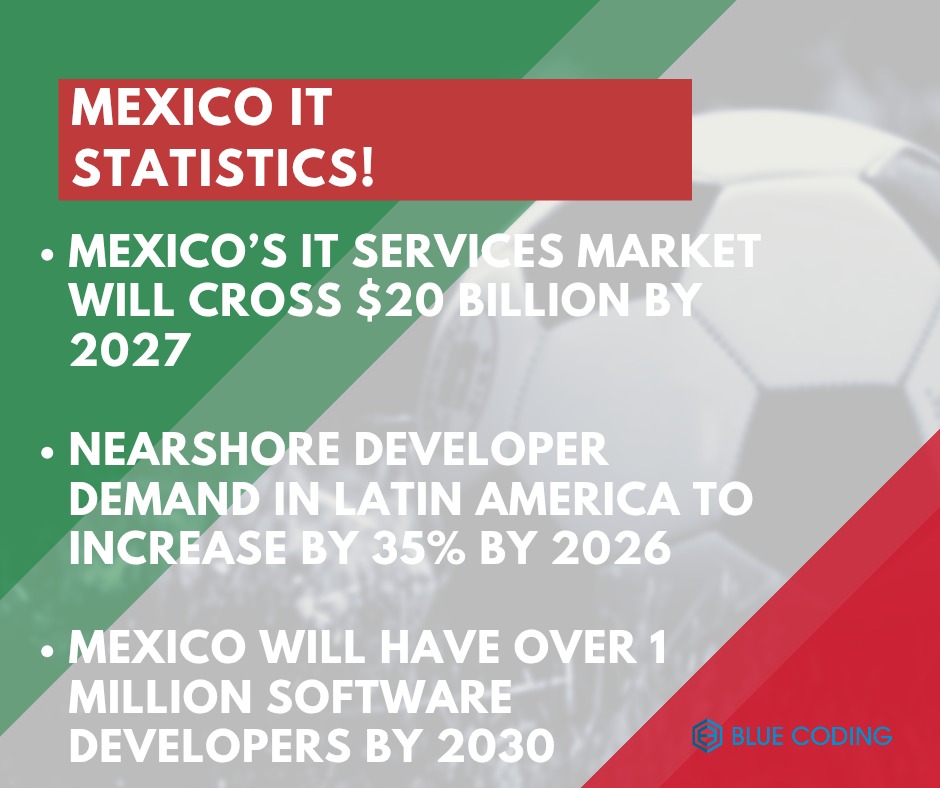 News
News
Mexico, the USA’s next-door neighbor, is known for its diverse and delicious cuisine, beautiful ancient ruins, and white sand beaches. Home to 128 million people, Mexico is also a top choice for companies looking to hire top-level software engineers in Latin America.
Software Development in Mexico & Hiring Nearshore Developers
Mexico is home to many top software engineering firms, ranging from small and well-known consultancies like Codebay and Teravision to large multinationals like Oracle. Mexico is also home to large financial institutions like BBVA, Santander, and HSBC Mexico. These have strong software engineering divisions, and many software engineers in Mexico work with financial institutions at some point in their careers. As with many countries, software engineers in Mexico tend to be based in the largest cities: Guadalajara (home to the majority of the country’s developers), Ciudad de Mexico (the capital), and Monterrey, though there are plenty of talented developers scattered throughout the country in less populous areas, as well.
It’s interesting to note that different cities in Mexico tend to specialize in different languages and areas of expertise. For example, the best full-stack developers, as well as front- and back-end developers, can be found in Guadalajara. If you’re looking for QA engineers in Mexico, Monterrey is a good bet. If you’re looking for the best web and mobile developers in Mexico, the Ciudad de Mexico is a good place to start.
Why You Should Hire Developers in Mexico
Hiring developers from Mexico presents a strategic advantage for businesses looking to enhance their technological capabilities while ensuring cost-effectiveness and quality. Mexico has emerged as a prominent nearshore development destination for several compelling reasons:
Proximity and Time Zone Alignment:
One of the primary benefits of working with Mexican developers is their geographical proximity to the United States and Canada. This proximity facilitates smoother collaboration and communication due to minimal time zone differences, allowing for real-time interactions and faster decision-making processes. It ensures that project milestones are met with greater efficiency, enhancing productivity and reducing time-to-market for new products and services.
Cost-Effective Talent:
Mexico offers access to a pool of highly skilled developers at a significantly lower cost compared to their counterparts in the U.S. and Canada. This cost advantage does not come at the expense of quality; Mexican developers are well-known for their technical proficiency, creativity, and innovation. Businesses can leverage this cost-effectiveness to scale their development teams, optimize their budget, and invest savings into other critical areas of their operations.
Cultural Affinity:
Mexican and other nearshore developers share a cultural affinity with U.S. and Canadian businesses, which is a crucial factor for seamless integration into existing teams. This cultural alignment minimizes misunderstandings and fosters a collaborative working environment, thereby enhancing team dynamics and project outcomes.
Strong Educational Background:
Mexico has a robust educational system with numerous universities and technical institutes focusing on engineering and technology, producing a steady pipeline of talented developers. These institutions often collaborate with the tech industry to ensure that the curriculum is aligned with current market demands, thereby equipping graduates with the skills and knowledge required to tackle contemporary technological challenges.
Growing Tech Ecosystem:
Mexico's tech ecosystem is vibrant and rapidly growing, supported by government initiatives, investments in technology parks, and a flourishing startup scene. This dynamic environment encourages continuous learning, innovation, and entrepreneurship among Mexican developers, making them well-versed in the latest technologies and development methodologies.
Overall, hiring developers from Mexico offers businesses a unique blend of advantages, including cost savings, talent quality, cultural compatibility, and strategic geographic location. These benefits make Mexico an attractive destination for companies seeking to augment their development capabilities and drive digital transformation initiatives effectively. Whether you pick staff augmentation or BOT, you’ll find yourself hiring the right talent at the right price!

What Skills Are the Most Common in the Mexican Software Talent Pool?
If you're exploring development options in Mexico, you'll find a solid mix of technical expertise, practical experience, and adaptability. Here’s a snapshot of the most commonly found skills among Mexican developers:
JavaScript & Front-End Frameworks: React, Angular, and Vue are widely mastered by Mexican developers, especially for UI-heavy projects.
Java & .NET Expertise: Strong presence in enterprise-grade backend development using Java and Microsoft technologies.
Python & Django: Popular for startups and data-heavy applications, with growing demand in AI and machine learning.
Mobile Development: Skilled in React Native, Flutter, and native Android/iOS for cross-platform and mobile-first builds.
DevOps & Cloud Tools: Familiar with AWS, Azure, Docker, Jenkins, and Terraform, often integrated into daily workflows.
Database Management: Solid command of both SQL (PostgreSQL, MySQL) and NoSQL (MongoDB) systems.
Agile Methodologies: Teams are well-versed in Scrum, Kanban, and remote-friendly collaboration tools like Jira, Trello, and Slack.
English Communication: High proficiency in written and spoken English, especially among developers with international project experience.
5 Tips For a Successful Interview With Mexican Developers
Start With a Warm Introduction and Cultural Awareness:
Mexican developers tend to appreciate a warm, respectful tone in conversations. Start with a brief personal intro and a few casual questions to break the ice. This helps establish trust and sets a collaborative tone for the rest of the interview.
Keep Questions Focused and Structured:
While open-ended discussions can be helpful, it’s a good idea to keep interview questions structured and clear. Many developers in Mexico are used to working with international teams and will respond well to clearly outlined expectations. Consider using practical, scenario-based questions to better assess how they think through real-world problems.
Check for Communication and English Proficiency Organically:
Most developers in Mexico, especially those with international experience, have strong English skills, but it’s still important to assess this early on. Instead of formal testing, gauge their fluency through casual conversation and questions related to past projects. This also gives insight into how well they’ll communicate with your current team.
Ask About Collaboration and Past Team Experience:
Mexican developers often come from team-based environments, especially those who’ve worked in larger tech firms or startups. Ask questions like “Can you tell me about a time you worked closely with a product team?” or “How do you usually handle feedback?” This gives you a clearer picture of how they’ll integrate with your team’s workflow.
Be Transparent About Compensation, Benefits, and Next Steps:
Because demand for skilled developers in Mexico is high, transparency during the interview process is key. Clearly outline your compensation structure, what the working relationship would look like (contractor, full-time, etc.), and what the next steps are. This not only builds trust but also helps set mutual expectations early on.
Most Popular Languages and Technologies in Mexico
Among the top languages and technologies used by developers in Mexico are:
Ruby, Ruby on Rails
Python, Django, Flask
JavaScript, VueJS, Angular, React, TypeScript, Node.js, jQuery
PHP, Laravel, WordPress, Symfony, CodeIgniter
Other languages and technologies used in Mexico:
Average English Level of Developers in Mexico

One of the benefits Mexico has, given its proximity to the US, is that developers tend to have excellent English. Many are even native speakers, meaning you can expect a seamless level of communication in your working relationship. Another major advantage is cultural overlap with the US. Because many Mexican software developers have worked with US companies in the past, they are generally familiar with US working conventions and tend to adapt quickly to their new teams. One good way to understand the nuances of the average English level of Mexican developers is to check the EF EPI Index. Currently, Mexico has a low English proficiency as the national average, but this is not the average for most young educated professionals.
Understanding the Key Engagement Models to Hire Developers in Mexico
When it comes to building a development team in Mexico, there’s no one-size-fits-all approach. Depending on your project needs, team size, and long-term goals, different engagement models can offer varying levels of control, flexibility, and commitment. Here's a breakdown of the most popular models to help you choose the right fit.
Staff Augmentation: Flexibility Without the Full-Time Commitment 》
If you're looking to scale your team quickly without going through the long process of hiring full-time employees, staff augmentation is often the go-to model. In this setup, you bring Mexican developers on board to work as extensions of your internal team. They follow your systems, attend your meetings, and stay aligned with your project goals without being on your company’s payroll. This model works especially well when you need to plug skill gaps or speed up delivery without overcommitting on resources.
Dedicated Development Teams: Long-Term Partnership, Local Talent 》
Hiring a dedicated development team from Mexico gives you the best of both worlds, with full focus and long-term collaboration, but with reduced operational overhead. These teams work exclusively on your projects, often managed by a local project lead or in sync with your existing team. This model is great if you’re working on a complex product that requires ongoing development, or if you want to build a nearshore team that functions like an internal unit without setting up an office in Mexico yourself.
Project-Based Outsourcing: Ideal for Fixed Scope and Budget 》
When you have a clearly defined project with a set timeline and budget, project-based outsourcing might be the right fit. You’ll typically collaborate with a Mexican software agency or outsourcing partner, who takes full ownership of delivery. It’s a hands-off model that reduces your managerial burden, but it does require a solid brief and clearly outlined expectations from the start. This model is ideal for companies with limited tech capacity in-house or for those experimenting with a new idea before scaling it further.
Freelance or Contract-Based Hiring: Best for Short-Term Needs 》
Sometimes, all you need is one great developer for a short burst of work, whether it’s building a feature, fixing bugs, or helping with a migration. Freelancers or independent contractors in Mexico are relatively easy to find, especially through specialized platforms or local networks. While this model is cost-effective and flexible, it usually works best when your project needs are limited in scope and you have the ability to manage the work directly.
Build-Operate-Transfer (BOT): Your Own Team, Without Starting from Scratch 》
The BOT model is a long-term strategy for companies looking to establish a real presence in Mexico without the hassle of setting up operations right away. A local partner builds and manages a development team for you, handling everything from hiring to office setup. Once the operation is stable and running smoothly, it gets transferred to your ownership. This approach is ideal for companies planning to grow in the region but want to test the waters first with expert guidance.
Software Engineering Education for Mexican Developers
Software engineers and coders in Mexico come from a variety of backgrounds, but often acquire their education through one of these:
University: Mexico has approximately 1250 public and private universities across the country, providing a steady stream of well-educated software engineers. Some of Mexico’s top universities for computer science and similar degrees are the Centro de Enseñanza Técnica y Superior (CETYS University), Universidad Anáhuac Mayab, the Technological University of Leon, and Gauss Jordan Specialized Institute in Computer Science and Administration (which also provides students with valuable insight on business organization and administration).
On the job: The large number of established multinationals, startups, and consulting firms operating in Mexico give software engineers an excellent opportunity to learn on the job. It’s common to work with developers who have worked with, for example, EY, large investment banks, or cutting-edge startups, giving them a chance to gain valuable real-life experience that they can apply in future roles.
Bootcamps and other institutions: Mexico boasts a large number of acclaimed bootcamps to help people learn to code and polish their skills. Le Wagon, Iron Hack, Laboratoria, Kodemia, and HolaCode are all known for their comprehensive programs, and there are more popping up all the time.
Self-taught: As in most places, Mexico also has a large (and growing) number of self-taught programmers in the workforce.
How to Hire Developers in Mexico
Even with its large developer population, competition is fierce for the best programmers in Mexico. A few places to find and hire software engineers in Mexico are:
Outsourcing or nearshoring firms:
Hire through a firm like Blue Coding which has established networks of developers in the region and understands the local laws and regulations.
Referrals:
Request referrals from colleagues or contacts in Mexico. Some of the most successful developers we’ve placed on projects have come to us via referrals from our best developers.
Job boards:
There are a huge number of job boards in Mexico where you might be able to locate talent, such as Computrabajo, Jooble for software engineers, OCC Mundial, and Opcionempleo (to name a few). You might need to post in Spanish!
Online communities:
It’s common for developers to gather and participate in social media groups on platforms like LinkedIn and Facebook. Check out local Facebook groups of developers in Mexico to see if you are able to post jobs there, but keep in mind you may need to check the rules to see whether posting jobs is allowed and what format you must follow.
Networking and local events:
In most major cities throughout Mexico, especially Guadalajara, Monterrey, and Ciudad de Mexico, there are a variety of in-person events that can be a great place to meet software developers. The best way to find these events is generally via referrals, joining local development groups, or platforms like Meetup.com.
Engagement Models for Hiring Software Developers in Mexico
Hire Through an Outsourcing or Nearshoring Firm:
Nearshore development firms can help you hire developers in Mexico without having to handle the bulk of the work. These companies have a deep understanding of Mexico’s local regulatory landscape, as well as the tax and HR concerns that can arise when hiring developers abroad. Most of these companies are able to offer several engagement models, including staff augmentation and custom development, and some may also offer recruitment and direct placement services.
Hire Directly Through GEO or PEO:
Global employment organizations and professional employment organizations are often used by large companies that are looking to establish a foothold in a new region. They use local legal entities, through which they can hire software engineers as employees for another organization. The fees usually charge the total cost of employee salary, benefits and other costs plus a fee of 10% or more.
Hire Mexican Developers Using Freelancing Platforms:
Platforms like UpWork, Freelancer.com, or Fiverr will facilitate payments and time management, but you need to make sure you and your contractor are following all relevant employment and tax laws to ensure you are shielded from legal liability. One downside to these platforms can be that it’s challenging to evaluate candidates before beginning work, so you may have a few misfires before finding the right developer(s).
Hire Directly As a Contractor:
Another way to hire is to simply contract a developer directly. Many contractors in Mexico are accustomed to working as contractors with US companies. It is important to ensure that the contractor is following all relevant local laws and reporting their taxes correctly to avoid legal liability from your organization’s perspective.
Establish a Local Company:
If you are building a larger team, you may want to create a local subsidiary of your company in Mexico through which you can hire all of your Mexican employees. This will allow you to be compliant with all local laws and regulations around employment and taxes.
Average Software Developer Salaries in Mexico
Mexico, and in particular the larger tech hubs like CDM, Guadalajara, and Monterrey, can have slightly elevated costs of living compared to the rest of Latin America. Due to the high demand for talented software engineers, it is not uncommon to find top engineers in Mexico asking for salaries comparable to some areas of the US. For remote companies looking to hire in Mexico, these ranges will give you an idea of how much to pay experienced developers with high English levels:
Junior developers: $2000-$3000 USD per month.
Mid-level developers: $3000-$3500 USD per month.
Senior developers: $3500-$7000 USD per month.
Certain technologies, such as Ruby on Rails, may be even more expensive to hire for because of the increased demand in recent years.
If you are hiring through a third-party firm, keep in mind that there will be a 30% to 50% increase in the rates described above.
Looking to Hire Software Developers in Mexico?
At Blue Coding, we have been working with developers in Mexico since 2010, and have a broad network of great software developers, project managers, QA engineers, and designers that we can connect you with. We offer both staff augmentation and direct placement services, and have a thorough vetting process to ensure that we only introduce engineers who are the right fit for your team. If you would like to have a conversation about how we can help you hire developers in Mexico, book a free strategy call here!



